Introduction
Use this guide to replace the battery in your Samsung Galaxy S9.
Opening the Samsung Galaxy S9 will damage the waterproof seals on the device. If you do not replace the adhesive seals, your phone will function normally, but will lose its water protection.
Before disassembling your phone, discharge the battery below 25%. If your battery is swollen, do not heat your phone. Swollen batteries can be very dangerous, so wear eye protection and exercise due caution, or take it to a professional if you're not sure how to proceed.
You’ll need replacement adhesive to reattach components when reassembling the device.
Tools
Parts
-
-
Before you begin, switch off your phone.
-
Apply a heated iOpener to a long edge of the phone to loosen the adhesive beneath the rear glass. Apply the iOpener for at least two minutes.
-
-
-
In the following steps, you'll be cutting through the adhesive securing the back cover.
-
You'll be slicing through the adhesive in the areas shown:
-
Thick portions of adhesive
-
Thin areas of adhesive
-
Avoid prying or slicing in this area, to protect the fingerprint sensor flex cable.
-
-
-
Press a suction cup onto the back cover.
-
Lift the back cover's bottom edge with your suction cup, opening a slight gap between the back cover and the frame.
-
Insert an opening pick in the gap you created and slide it to the bottom right corner.
-
Insert a second opening pick and slide it to the bottom left corner.
-
Insert a third opening pick to prevent the adhesive from resealing during the rest of the removal procedure.
-
-
-
While inserting only the tip of the opening pick, slide it from the bottom left corner along the side to the top.
-
Slide the pick around the top corner and leave it there to prevent the adhesive from resealing.
-
-
-
Slide the opening pick from the bottom right corner along the side to the top.
-
Slide the opening pick around the corner and cut the remaining adhesive at the top of the phone.
-
-
-
Carefully lift the side of the rear glass where the volume button is located.
-
Use the edge of a spudger to pry up and disconnect the fingerprint sensor flex cable.
-
-
-
Insert an opening pick under the right side of the plastic cover containing the NFC antenna and charging coil.
-
Twist or pry to release the plastic clips securing the cover.
-
-
-
Insert an opening pick under the left side of the plastic cover.
-
Twist or pry to release the plastic clips securing the cover.
-
-
-
Use an iOpener to loosen the adhesive beneath the battery. Apply the iOpener for at least two minutes.
-
In the following step, only apply the spudger in the areas marked in green, which is where the battery adhesive is located.
-
Avoid this area. There's a gap in the mid-frame right below the battery, and you can accidentally damage the display through it.
-
-
-
Insert the flat end of a spudger at the top left corner of the battery where the flex cable is located and start to pry it up.
-
Work your way down the left side of the battery and loosen the adhesive with the spudger.
-
To reassemble your device, follow these instructions in reverse order.
If possible, turn on your phone and test your repair before installing new adhesive and resealing the phone.
For optimal performance, calibrate your newly installed battery after completing this guide.
Take your e-waste to an R2 or e-Stewards certified recycler.
Repair didn’t go as planned? Check out our Answers community for troubleshooting help.
22 comments
An exceptionally useful, and dare I add - well-written - fixit.
Merci ifixit.
Mais je n ais pas compris la deconnection du NFC, es une nappe. Je ne comprends pas.
Di Da -
Bonjour @Di Da, vous trouverez la partie qui parle de la démontage du coque / de la cache en plastique qui abrite l'antenne NFC et la bobine de recharge dans les étapes 9 à 11. Au fait, la cache en plastique et la nappe sont UNE pièce ensemble, on ne peut pas les séparer et dès que vous démontez la cache, la nappe va elle aussi sortir automatiquement. Elle n’est lié que par quelques contacts, vous n’avez pas besoin de déconnecter ceux-ci, ils se séparent automatiquement quand vous retirez la coque.
Wenn nach Abschluss der Reparatur der Fingerabdrucksensor nicht funktioniert muss man in den Restore Modus des Handy gehen.
Dazu das Smartphone an den Lader hängen und das Gerät ausschalten.
Dannach die Bixby + Power + Lauter Taste gedrückt halten bis das Samsung Logo erscheint.
In dem Menü den Punkt “Wipe Cache Partition” auswählen mit Lauter / Leiser und mit Power die Auswahl bestätigen.
Die Auswahl nochmal mit Yes bestätigen und warten bis das Gerät die Cache Partition gelöscht hat und das Gerät neu starten.
Dannach sollte der Fingerabdrucksensor wie gewohnt funktionieren.


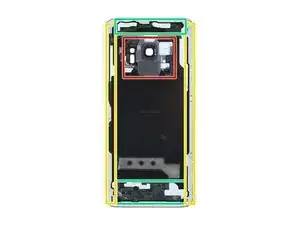


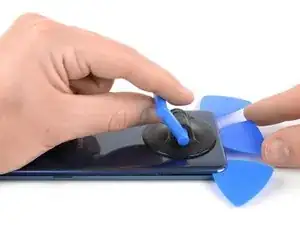















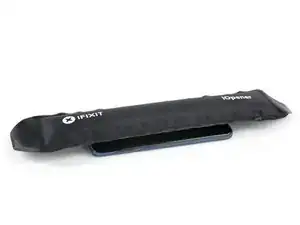
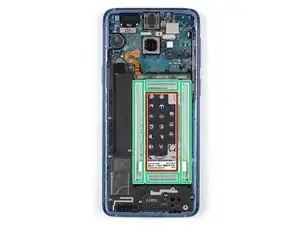
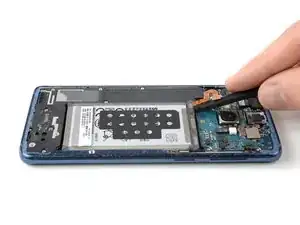
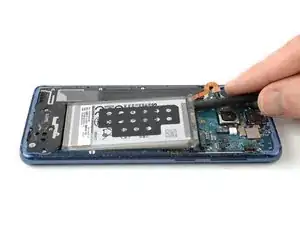
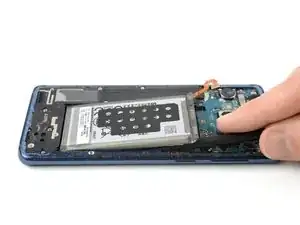
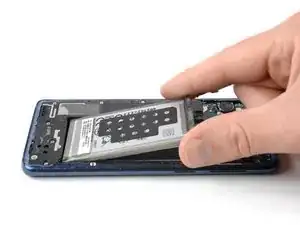

Nightmare. Impossible to get the back off so far. Being trying using the iOpener with hair dryer for last 1hr. No chance.
Chris Bunney -
You’re right Chris. I’ve tried on 3 separate occasions now and haven’t been able to budge that back. All that has happened is the pick has taken a piece out of the glass back leaving a rough edge now.
grahamcatto -
it was not easy but doable.
Clinton Stark -
It’s difficult, but the trick I did to get it was to wrap the hot iOpener around a bottom corner, apply the suction cup, then I covered the opener and phone with a paper plate, better insulating the area. Then I set my blow dryer to high heat and low velocity and heated the area under the plate for about a minute. Right after turning off the blower, I took off the plate and pulled the suction cup with a cutter at hand. You’ll hear a bit of a cracking/popping noise when the adhesive is starting to give, just apply a little more force and push the cutter at the seam. This method worked great for me, so good luck and just keep at it — you’ve got this!
Nicholas Weger -
I used nearly boiling water in a storage zip bag on the phone for 10 minutes. I can’t really recommend this method, but thankfully the bag did not leak - an iOpener is probably a much better way to go. Regardless, the bag covered the entire back of the phone, and the phone was too hot to hold, but I still could not get the glass to budge with the suction cup after struggling with it for about an hour and multiple reheats. I ended up epoxying a 2”x2” square of PVC board to the bottom of the cover and built a relatively complex fixture that pulled on the PVC with the turn of a screw while it held down the frame by the edges. After heating the edges up again It did lift the glass enough to get a pick underneath it, but it cracked the glass and it was a pain to slide a pick around the edge while the glass was cracking all the way around. Once I finally got all the glass off, I spent the next 30 minutes (which is what this entire process is supposed to take… what a joke!) cleaning the adhesive off the phone.
drbenton815 -
Heavy Duty Heat Gun from popular discount tool store for the win!
Jesse Meyer -
Well, it is not obvious how to do this. I have no iOpener, but a heat cushion for remedy hurting muscles and sometimes a backpain. It is filled with grain of some kind and it is to be heated in a microwave oven for about 3 minutes. After that I enveloped this cushion round the phone and brewed myself a cup of tea. After ten miutes the phone was warm (almost hot) and I was able to press the tip of a small (very small) knife above the charging port into the connection between the phone body and the backplate. A very small opening emerged slowly (this is the critical point in this process) and I was able to start using the iFixit opening picks. It became obvious to me that the opening picks are too blunt to achive this with them. But after starting carefully with the (very small and very sharp) knife, everything went straight forward. Thou I had to give the phone a second heatpush with my heat cushion before the backplate came loose.
borutberg -
I used my 3D printer heat bed and heated it to 90 Celcius to succeed.
gahute -
It took about 3 minutes on my 90 C printbed to get the first pick in. If the suction cup gives up before the adhesive does, try using some Isopropyl alcohol to clean the back of the phone, and it should stick better. Also, don't apply heat to the screen, just in case that wasn't clear.
Evan Newman -
Used a corn bag (usually used for sore muscles) and incased the phone. It was hot to the touch, but it did the trick. Also needed a knife to have a small enough edge to start prying the back off and get the adhesive to finally pop.
Laurie Hallberg -
Don't Forget Step 0! Turn the phone Off and remove the SIM card tray. just to be safe, I'd recommend making a full backup of your phone onto a micro SD card in case the worst should happen. also, make sure anyone who needs to contact you knows you aren't currently available at your phone number.
Evan Newman -
We went for a hairdryer. Put it on hot, low blow and put the head right up to the corner. Took maybe 5 minutes per corner!
Robert Tomohamat -
Removing the back wasn't too difficult on my phone: several rounds of heating with the iOpener, applying gentle pressure with the suction cup, and eventually a corner lifted up without much force and I could easily slide a pick in. From there it was very straightforward and I had no trouble sliding the picks around and removing the back. The battery removal was much harder in comparison (especially as the iOpener burst when reheating in the microwave for the battery, despite following the time instructions).
Less eWaste -